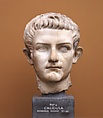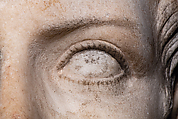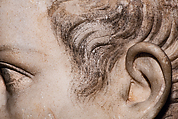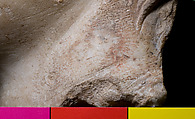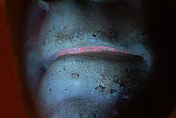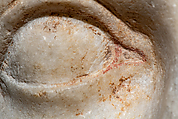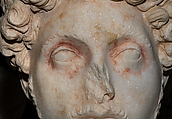Returned to lender The Met accepts temporary loans of art both for short-term exhibitions and for long-term display in its galleries.
Reconstruction of a marble portrait of the Emperor Gaius Julius Caesar Augustus Germanicus, known as Caligula, Variant B
Vinzenz Brinkmann German
Ulrike Koch-Brinkmann
Not on view
Rich traces of paint on a marble portrait of the Roman emperor Caligula were analyzed extensively using a wide range of scientific methods. Investigations identified pink madder between the lips and on the lower eyelid and a mixture of iron oxides with chalk on the flesh—especially on the neck under the right ear. The elegant loose hair at the temples, the eyelashes, and the pupils were painted with carbon black derived from burned bone, probably as a preliminary drawing on the marble.
"The origin of this life-size marble head of Caligula cannot be ascertained, although such imperial portraits functioned as propaganda during the Roman Empire, with carefully calibrated messages. The many traces of color on the portrait of the emperor Caligula in Copenhagen have been intensively analyzed. Rose madder was identified between the lips and on the lower eyelids, while on the skin - especially on the neck below the right ear - a mixture of iron oxide and chalk could be detected. The chemical analysis indicate that egg served as binding agent for the various pigments. The hair at the temples, the eyelashes, and the pupils were applied to the marble in a black pigment that was composed of charred bones. Since the color of the flesh is preserved, the intensive black pigment must be a preliminary drawing that was then covered by the flesh color. The experiment revealed that this underpainting was visible as a subtle shadow even after the application of the flesh color and apparently served as a preliminary drawing. This underpainting must have shown through the flesh color, providing an orientation for the accurate application of the fine hairs in reddish brown, as it would not have been possible to make a correction on top of the skin color.
The multi-colored rendering of the hair in the reconstruction follows that of the so-called Treu Head. The reddish-brown hair was applied to a foundation of yellow ocher. The individual locks of hair were then modeled with lines of dark and light brown that create a painterly effect. While the Variants A, B, and D emphasize an application of paint that is designed to be seen from a distance, the locks of hair in Variant C are rendered in great detail.
The skin on Variants A, C and D was rendered exactly how it was preserved on the original, yielding a flat, toneless color with no shading. However, it has been hypothesized that the skin would have been modeled with light and shadow in the manner of contemporary Roman paintings: In addition, the flesh tones of Variant B are enhanced by effects of light and shadow. The rendering of the eyes follows that of contemporary mummy portraits.
The whites of the eyes of Variants C and D included the use of Egyptian Blue, which has now also been detected on the original head. In Variant D (made in 2014 for the Cast Collection of the University of Gothenburg), the flesh tone has been chromatographically calibrated, and this matches exactly the color detected on the original."
Vinzenz Brinkmann and Ulrike Koch-Brinkmann
Reconstruction Variant B, 2005:
Vinzenz Brinkmann, Ulrike Koch-Brinkmann, Sylvia Kellner
artificial marble, natural pigments in egg tempera
H. 28 cm.
Liebieghaus Skulpturensammlung (Liebieghaus Polychromy Research Project), Frankfurt am Main, inv. St.P 691
Scientific methods employed:
Ultraviolet-induced visible luminescence imaging (UVL) (Schott KV 418),
Ultraviolet-reflected imaging (UVR) (Schott UG1 or Schott BG12)
Optical stereoscopic microscopy (10–50x, Zeiss and Olympus)
Reflected visible light imaging (Schott KL1500)
Visible-reflected imaging (VIS)
Color imaging in visible light (VIS)
Photomicrograph (with microscope or macro objectives)
X-ray fluorescence spectroscopy (XRF)
Scanning electron microscopy (SEM)
Energy dispersive X-ray microanalysis
Gas chromatography
Mass spectroscopy
Scientific evaluation:
Vinzenz Brinkmann, Sylvia Kellner, Ulrike Koch-Brinkmann, Jan Stubbe Østergaard, Heinrich Piening, Heike Stege
Pigments used in the reconstruction:
pink: rose madder; red: cinnabar, red ocher; yellow: gold ocher; brown: brown ocher; black: bone char; white: white lead; brown, red, and yellow ocher; flesh color: brown, red, and yellow ocher, chalk
Acknowledgements:
Doerner Institute, Munich
Ny Carlsberg Glyptotek, Copenhagen
Due to rights restrictions, this image cannot be enlarged, viewed at full screen, or downloaded.
This artwork is meant to be viewed from right to left. Scroll left to view more.


